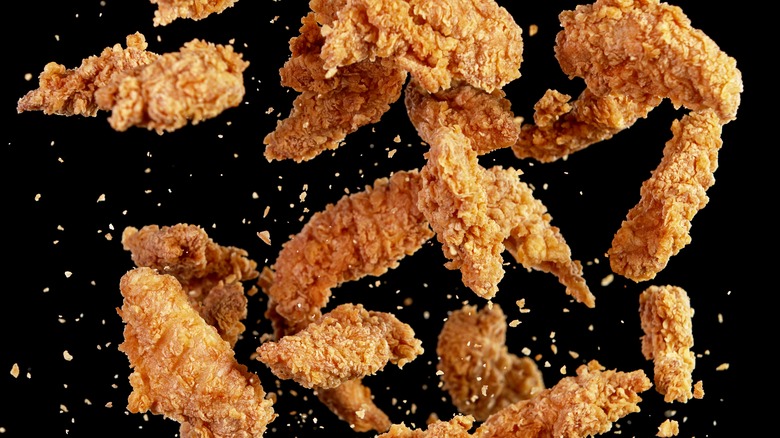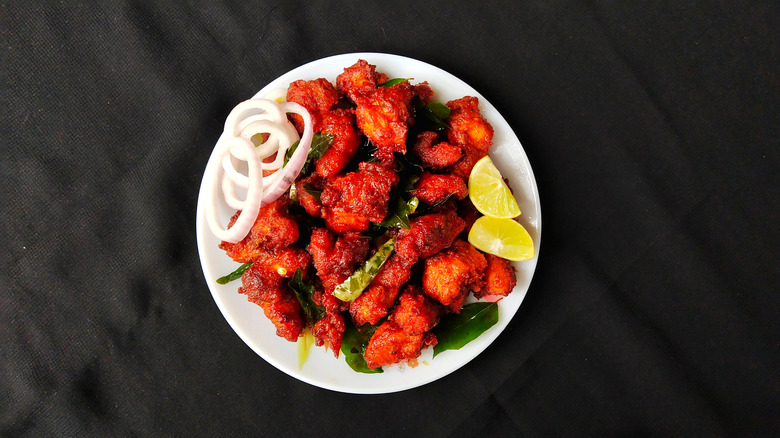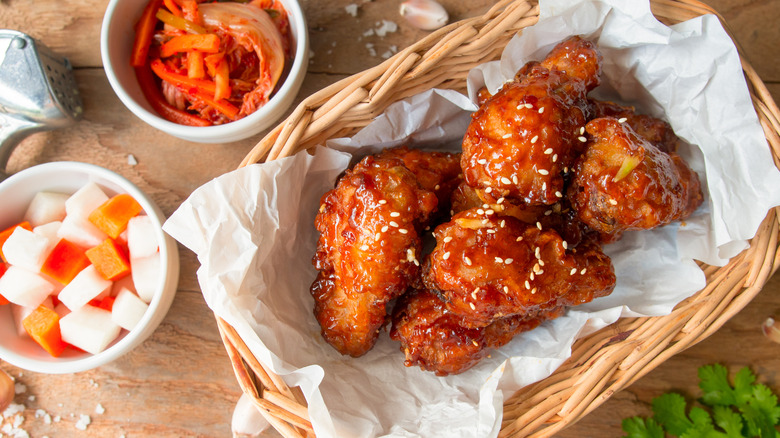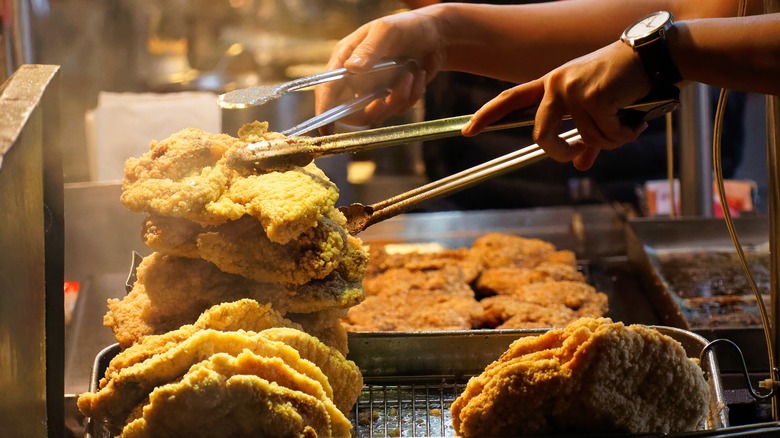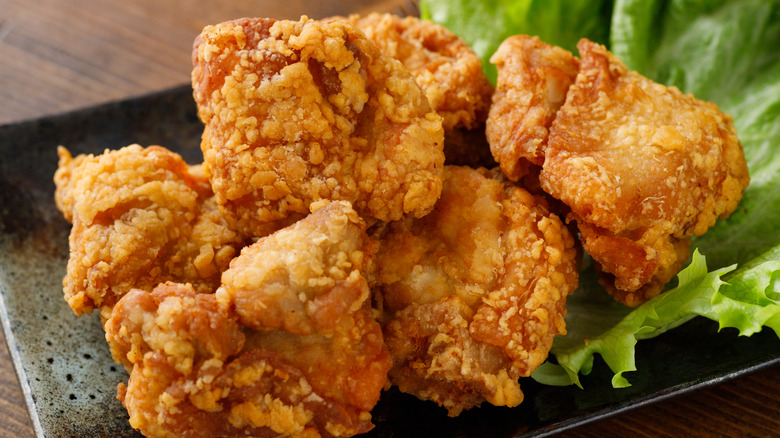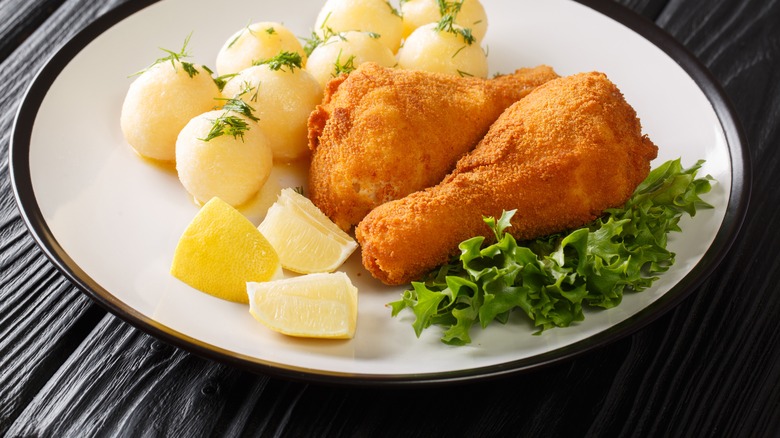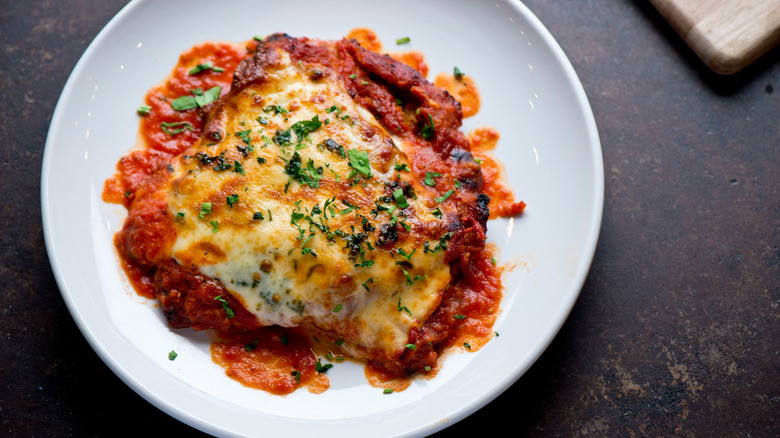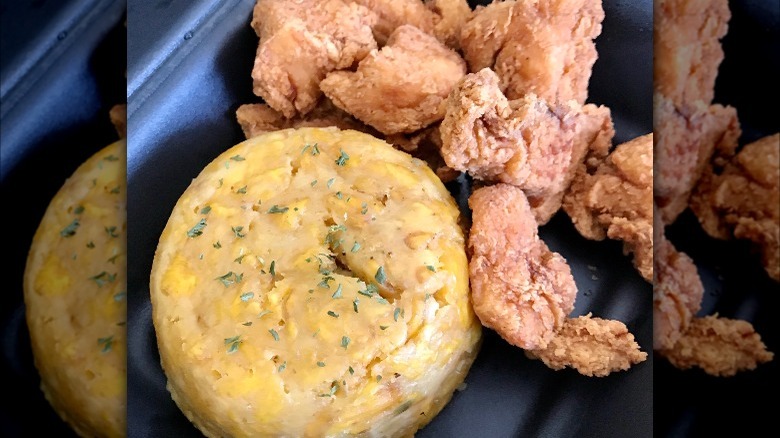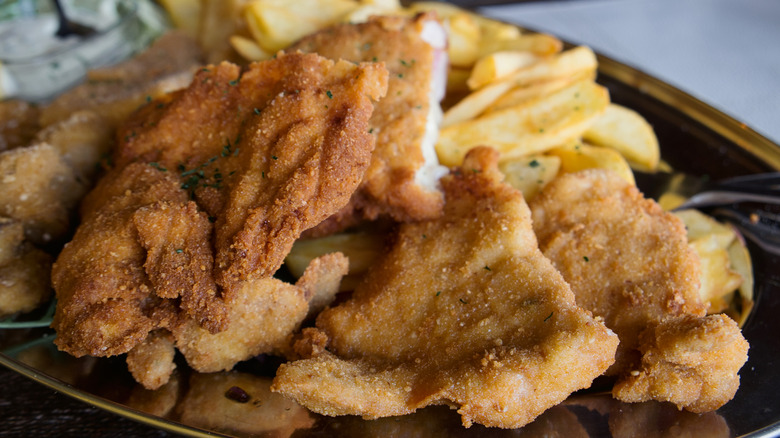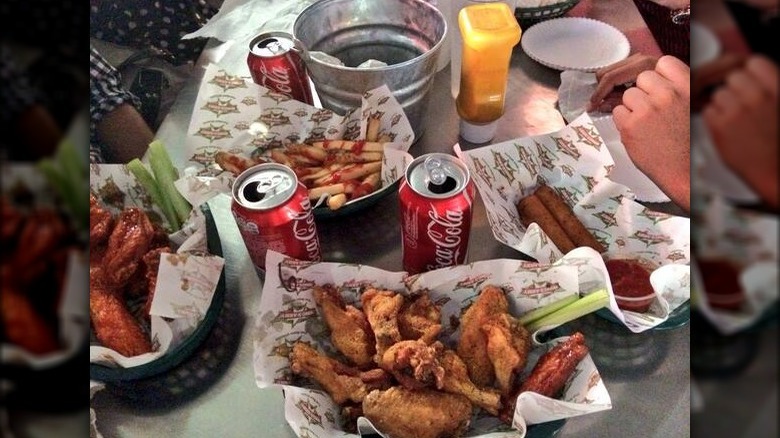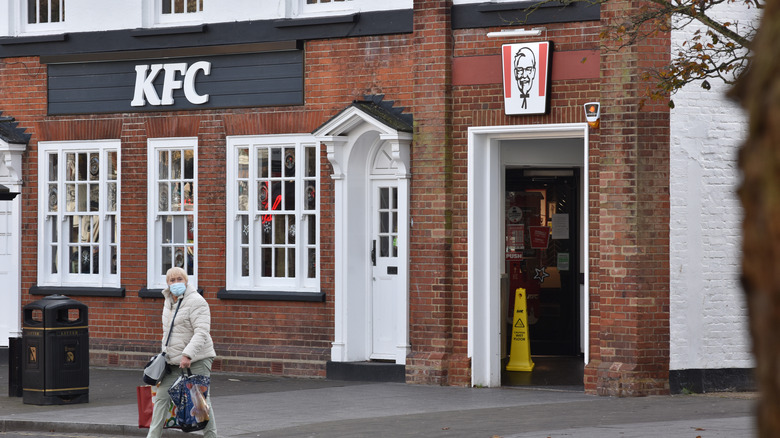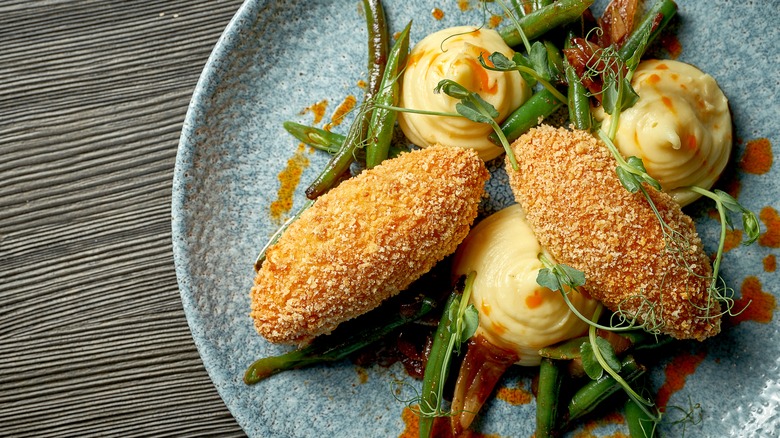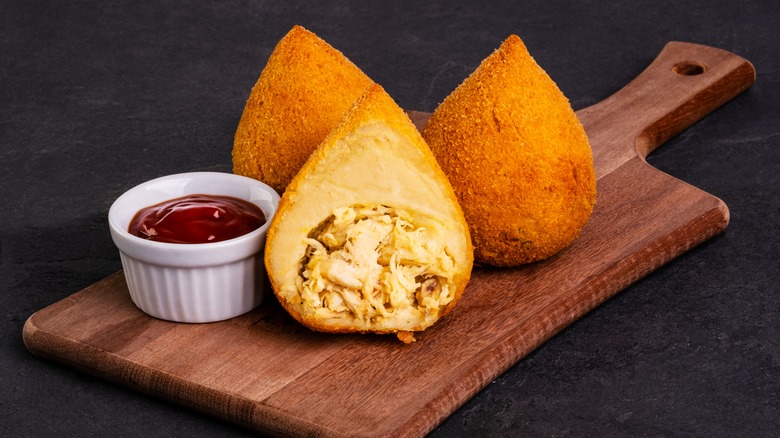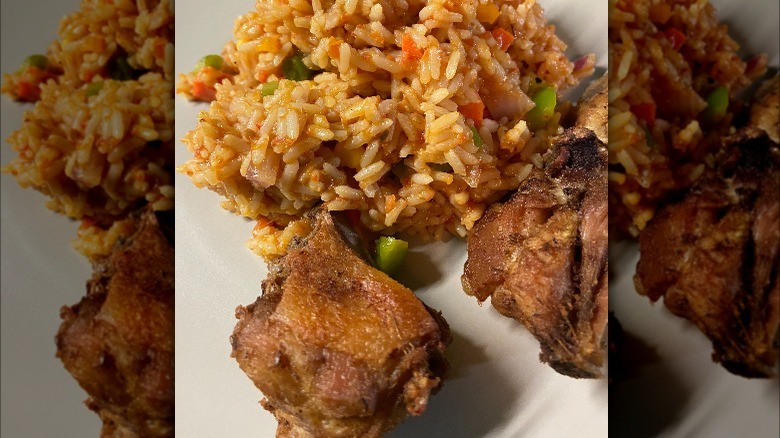How Fried Chicken Is Enjoyed In Countries Around The World
Chicken takes up significant space in the average American's diet. A National Chicken Council press release from July 2022 reported that, over the first half of the year, 99% of respondents to a survey said they ate meals including fresh chicken more than once a month, and 88% of respondents said they ate meals including fresh chicken more than once per week. The protein's popularity was attributed to its versatility, value, and nutrition.
But how many of those Americans are eating all the great fried chicken that's out there? A Fox Business report from 2020 said it was expected that more than 179 million Americans will consume frozen fried chicken at home by 2023. The takeout fried chicken market is expected to reach $8.25 billion by 2025, with North America responsible for more than a third of the market share. It's no secret, though, that chicken — and fried chicken specifically — is a popular entrée choice in the United States. But what about fried chicken in the rest of the world? While Americans may prefer their fried chicken homestyle, extra-crispy, or popcorn, some people around the globe enjoy their fried chicken in other ways.
The Southern United States
When many Americans think of "fried chicken," they also think of the South. Most of the fried chicken fast-food brands — KFC, Popeyes, and the like — boast their southern roots. However, fried chicken isn't entirely a southern invention. Its origins are a little more complex than that.
According to the BBC, it's suspected that the Scottish brought a harbinger of fried chicken to the American South when settling there centuries ago. Cookbooks and historical documents from 18th-century Scotland and Britain show frying methods for chicken and recount fried chicken dinners, and those methods made their way to the American South with Scottish immigrants. Once in the American South, though, the cooking method was adopted by enslaved African Americans, who both cooked the dish in the kitchens of white enslavers and adapted the most common fried chicken recipes to their own tastes (via The Ark Republic).
However, it's worth noting that enslaved African Americans didn't just take the Scottish recipes as they were; instead, they applied West African frying and braising techniques, which resulted in a new, perfected version of the dish that's more akin to the traditional southern fried chicken that you see today (via The Economist). Now, the South's take on fried chicken is, for many, considered the classic variant of the dish that takes on many different flavors around the world.
India
In India, as Homegrown reports, fried chicken is served in many different forms beyond the hot, fresh, and greasy morsels from the carts of street food vendors. Chicken 65, or Chennai fried chicken, is a popular appetizer that consists of small pieces of fried chicken in an extremely spicy sauce. While the origins of the dish's name are debated, some say that the "65" can be traced back to a menu number, while others argue that it's the number of days a chicken must be kept before it's right for the dish.
Indian diners also enjoy fried chicken marinated in a mixture of garlic, onions, ginger, turmeric, and other flavors before frying. The chicken is then added to a stew to create what's known as Arsa Beipenek. Parsi fried chicken is spiced with garam masala, turmeric, and chili powder. Thattukada fried chicken is either fried alongside onions and curry leaves or topped with them.
South Korea
South Korean fried chicken may be a little more familiar to American palates. South Korean fried chicken eateries are becoming more common stateside, especially in larger cities. Often, South Korean fried chicken is paired with beer (and what a spectacular pairing it is). The combination, as CNN Travel notes, even has its own name: chimaek. However, while this combination always includes beer and chicken, the form the fried chicken takes can differ as it can be boneless, covered in cooked leeks, or even topped with a sweet and spicy sauce.
South Korean fried chicken became popular in the 1970s when vegetable oil was cheap and readily available and the cost of chicken was cheaper. As a result of the economic crisis in the late 1990s, a wave of new fried chicken restaurants was opened in the country. Now, you can find some of these same South Korean fried chicken chains all over the world, including in the United States, such as KyoChon, which boasts a location in Los Angeles.
Taiwan
Taiwanese fried chicken is a street food staple in the country, but it's now receiving new life in the U.S. As The New York Times details, traditional Taiwanese fried chicken is quite different from what you might be accustomed to ordering at your favorite fast-food chain in the States. Popcorn-style fried chicken is seasoned with basil, and chicken breasts are butterflied and marinated in soy sauce, rice wine, and five-spice powder before being fried. Rather than dredging the fried chicken in flour, sweet potato starch is the go-to.
Now, you can find new takes on Taiwanese fried chicken in cities around the United States. You'll find it served alongside boba, covered in sauces, and even served on sandwiches and topped with pickles for a dining experience more like what American consumers are accustomed to. The approach makes Taiwanese fried chicken more appealing to hesitant U.S. diners, interviewees told The New York Times.
Japan
According to MasterClass, Japanese fried chicken, or karaage, is a popular appetizer throughout the country. Similar to tempura, but not quite the same, chicken pieces are marinated in soy sauce and cut into small portions that are dredged in flour or potato starch before frying.
As The Washington Post reports, the dish can also include other proteins or veggies fried in a similar way, but chicken is the most popular option. Historically, the dish could be traced to China, but now the word karaage is inseparable from Japanese culture. After frying, the bite-size chicken nuggets are served with dips like mayonnaise or lemon juice, along with garlic and ginger, as Chef Katsuya Fukushima, who spoke with The Washington Post, does at his restaurant. The dish is noted for its accessibility to foreigners, as well as its suitability for a range of situations, such as quick meals for kids or late-night bites at the bar.
China
Research fried chicken in China and you'll inevitably come upon lots of information on how KFC has dominated the Chinese fast-food fried chicken market. However, while American-style fried chicken has its place in Chinese culture, the country has its own takes on fried chicken, too. Fast-food chains serving Chinese variants of fried chicken became popular in the country in the 1990s and early 2000s (via Radii). These chains, compared to fast-food fried chicken spots in the United States, offer more affordable fried chicken that's served in smaller pieces that are easier to eat with chopsticks or skewers. They also feature a range of flavors you'll be hard-pressed to find at any KFC location, such as chili, cumin, tomato, and plum.
China also claims a historical fried chicken dish, called hulu chicken, which was first enjoyed millennia ago. The chicken was boiled and steamed before being fried whole and was said to be particularly moist and tender. However, this chicken dish didn't become a cultural staple due to the historic inaccessibility of animal fats for frying.
Austria
While it's not surprising to think of fried chicken as a part of American and Asian cultures, it's probably not the first thing that comes to mind when you think of Austrian cuisine. Austria brings to mind hearty comfort foods like schnitzel and strudels rather than fried chicken. However, the country does have its own take on the beloved dish. And, while you could argue that schnitzel could be in the fried chicken family, as it is a piece of flattened meat that's been breaded and fried, you're far more likely to find schnitzel made from veal or pork in Austria than anything else (via BBC).
Austria's backhendl, which originated in Vienna in the 1700s, is a much more apt comparison to fried chicken (via Taste Atlas). This fried chicken dish is made by rubbing a whole, small chicken with various spices and lemon juice, then cutting the chicken into its various parts before dipping it all in eggs, flour, and breadcrumbs. The chicken and offal are then fried and served alongside each other. Today, you'll see backhendl most commonly served with a squeeze of lemon, lettuce, fried parsley, and/or potato salad.
Italy
You know Italy's take on fried chicken. Served alongside red sauce and pasta and topped with melty cheese, chicken parmesan is fried chicken that doesn't look like traditional fried chicken, even if it has all the right elements. However, while you might find chicken parm at every Italian restaurant from coast to coast, you might get a few dirty looks if you try to claim that this dish is authentic Italian eats. As the Los Angeles Times is quick to note: Chicken parm isn't actually from Italy.
So, how did this style of fried chicken become a staple on Italian menus in the United States (and, honestly, just about everywhere other than Italy)? According to Italian foods brand Paesana, chicken wasn't always widely available in Italy. If Italians were going to bread and fry something, it was going to be eggplant. However, when Italians emigrated to the United States, they suddenly had access to lots of affordable protein, and quickly, chicken, pork, veal, and beef were incorporated into their dishes. By the 1950s, chicken parm was an indisputable part of Italian-American cuisine.
The Dominican Republic & Puerto Rico
In The Dominican Republic, chicharrón de pollo is the name of the fried chicken game. These crispy, crunchy little nuggets are a staple at local restaurants and beach stands, according to the food blog Dominican Cooking. Historically, the dish could have been made in a variety of ways — with salt, soy sauce, paprika, or rum for flavor and a coating of cracker crumbs rather than flour. However, as Dominican Cooking points out, every family has its own way of cooking this dish, but there are two key things that are always the same: The chicken must be cut into small pieces, and it should always be fried, skin-on, until very crispy. Dominican Cooking's recipe for chicharrón de pollo incorporates oregano and garlic powder, along with flour, salt, and pepper like in the traditional American dredge for fried chicken. The end result is served with lime wedges.
Nearby, in Puerto Rico, chicharrón de pollo is also popular, though, in this case, as food blog Salima's Kitchen explains, there are a few key differences. The chicken (still portioned into small pieces) is marinated in lime juice, adobo, and other spices before being fried and garnished with lime.
Croatia
Among Taste Atlas' six most popular Croatian chicken dishes is one fried chicken dish, pohani v. Originating in Virovitica, the dish is made from chicken breasts that are cut in the shape of a — what else? — letter "v." The chicken breasts are seasoned, dredged in flour, eggs, and milk, then covered in bread crumbs before they're fried in oil. Traditionally, the chicken breasts are served with sour cream or a cream and horseradish mixture.
However, this isn't the only fried chicken dish in the country. As Total Croatia News reported in 2019, a new fast-food chicken brand, Vruča Čuča, was launched that offered North Croatia-style fried chicken. The chicken is made with the requisite eggs, flour, breadcrumbs, and spices and is fried in a kotlovina dish, which is a large, shallow cooking dish traditionally used in outdoor, open-fire cooking. The chicken is traditionally accompanied by an order of fries, along with crispy, fried onions, and lime or lemon slices. A dipping sauce adds the finishing touch.
Mexico
Mexico, as Vice says, has a "love affair with chicken wings." The publication credits the similarities between traditional Mexican food and chicken wings — both have their fried and spicy elements. However, the article is quick to note that the chicken wings you'll find in Mexico are basically the same thing you'll find in the United States, and for a reason. American-themed restaurants have become successful in Mexico, with the restaurant chain Wings Army and Buffalo Wild Wings staking claims in the country. As the article says, "The cosmopolitan wave of wing bars in Mexico symbolize a long-running fascination with American wealth."
However, while Mexico City may love American fried chicken wings currently, fried chicken is nothing new in the country. Historically, Mexican chefs and home cooks have borrowed the dish from the north of the border (as well as other countries) and subsequently put their own spins on it. For example, Mexican artist Frida Kahlo was known to cook up some fried chicken with peanut sauce on occasion, according to the 1994 cookbook "Frida's Fiestas," written by Kahlo's stepdaughter (via Yahoo Food). Kahlo's take on fried chicken was a mix of German and Mexican ingredients that resulted in what food historian Jeffery Pilcher described to Yahoo Food as a little like "reverse chicken schnitzel."
England
If you're going to talk about any fried protein served up fast-food style in England, chances are good you'll be talking about fish and chips. However, England has its own relationship with fried chicken, both historical and current.
Historically, according to Londonist, the earliest recipe for fried chicken in England popped up in the 1700s, detailing how home cooks would batter and fry whole chicken parts in lard. However, while fried chicken was an option in England three centuries ago, it wasn't necessarily a popular one when dining out. The first known purpose-built chicken restaurant in London was the KFC outpost that opened in 1968. In more recent years, however, The Guardian says Britain has experienced a "fried chicken boom." From 2003 to 2008, fried chicken retailers, the publication reported, saw a nearly 40% growth in sales. In 2019, IFT says, the total number of affluent British consumers visiting chicken restaurants rose to 45%. However, IFT also said that more consumers are interested in other countries' takes on fried chicken as well, with growing British interest in Korean fried chicken chains.
Ukraine
If we're considering Ukraine chicken dishes, chances are good you're going to think of chicken Kyiv (commonly known as chicken Kiev). The name of one of Ukraine's biggest, most well-known cities is right in the title, after all. However, while the country definitely embraces this fried chicken comfort food dish, according to NPR, it can't claim that it created it. Instead, that honor goes to the French. The story goes that, in the 1800s, Russian chefs went to Paris to learn how to cook some of the best cuisines in the world. They came back with a recipe for deep-fried veal, but they switched out the veal for chicken.
The dish quickly gained popularity, and it was dubbed chicken Kyiv when it made its way to Russian restaurants in the United States. When Americans traveled to Kyiv and began requesting the dish there, Ukrainian chefs acquiesced, fine-tuning the dish, with its buttery center, fried exterior, and small intact bone. Today, you'll find chicken Kyiv not only in Ukrainian restaurants but also served in fast-food outlets and grocery stores.
Brazil
Brazil has a particularly unique take on fried chicken: the coxinha. As Culture Trip explains, these little spheres, fried until golden brown, are meant to resemble chicken thighs (the name literally means "little thigh" in Portuguese). However, this isn't just a piece of chicken, battered and fried until crispy. Instead, the iconic Brazilian dish is primarily dough-based. Flour and chicken broth are combined to create a dough, and then the dough is filled with seasoned, shredded chicken and sometimes cheese. The dough is sealed and formed into a drumstick-like shape and then deep fried to a golden brown. So, you get the deliciousness of deep-fried goodness, chicken, and bread, all in one bite.
Different takes on the traditional recipe use potatoes or cassava instead of flour and, occasionally, the chicken filling is swapped out for something like pork or veggies. Coxinhas can be found just about everywhere in Brazil, from restaurants to gas stations.
Nigeria
Nigerian fried chicken sets itself apart in several key ways. As Simply Recipes describes, the chicken is firstly slow-cooked in spices and then fried in oil for a crispy finish. Nigerian chickens are also typically tougher than your average American chickens. The article goes on to describe how Nigerian chicken is usually chewier, drier, and less plump than their U.S. counterparts due to the way these chickens are raised. However, this added toughness makes it possible for Nigerians to slowly cook the chicken for hours while slowly finessing its textural profile. Slow cooking also creates deeper flavors and a rich stock that can be used in other items on the menu or down the line.
A traditional Nigerian fried chicken must be boiled with curry, onions, thyme, garlic, ginger, and peppers for up to an hour to make the meat more tender. It is then fried and may be covered in a peppery sauce.
